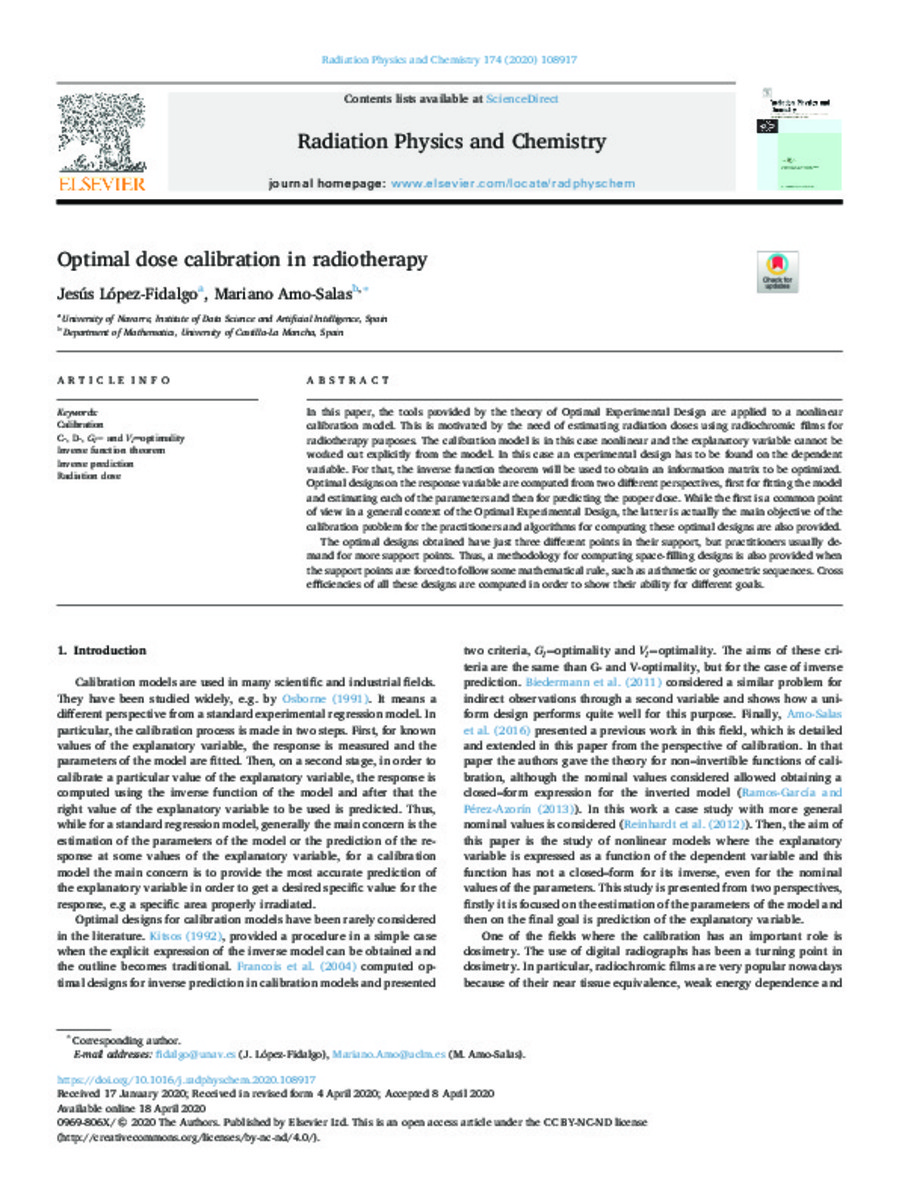Full metadata record
| DC Field | Value | Language |
|---|---|---|
| dc.creator | López-Fidalgo, J. (Jesús) | - |
| dc.creator | Amo-Salas, M. (Mariano) | - |
| dc.date.accessioned | 2020-07-29T13:52:04Z | - |
| dc.date.available | 2020-07-29T13:52:04Z | - |
| dc.date.issued | 2020 | - |
| dc.identifier.citation | López-Fidalgo, J., & Amo-Salas, M. (2020). Optimal dose calibration in radiotherapy. Radiation Physics and Chemistry, 174, 108917. | es_ES |
| dc.identifier.issn | 0969-806X | - |
| dc.identifier.uri | https://hdl.handle.net/10171/59132 | - |
| dc.description.abstract | In this paper, the tools provided by the theory of Optimal Experimental Design are applied to a nonlinear calibration model. This is motivated by the need of estimating radiation doses using radiochromic films for radiotherapy purposes. The calibration model is in this case nonlinear and the explanatory variable cannot be worked out explicitly from the model. In this case an experimental design has to be found on the dependent variable. For that, the inverse function theorem will be used to obtain an information matrix to be optimized. Optimal designs on the response variable are computed from two different perspectives, first for fitting the model and estimating each of the parameters and then for predicting the proper dose. While the first is a common point of view in a general context of the Optimal Experimental Design, the latter is actually the main objective of the calibration problem for the practitioners and algorithms for computing these optimal designs are also provided. The optimal designs obtained have just three different points in their support, but practitioners usually demand for more support points. Thus, a methodology for computing space-filling designs is also provided when the support points are forced to follow some mathematical rule, such as arithmetic or geometric sequences. Cross efficiencies of all these designs are computed in order to show their ability for different goals. | es_ES |
| dc.description.sponsorship | This work was sponsored by Ministerio de Economía y Competitividad MTM2016-80539-C2-1-R and by Consejería de Educación, Cultura y Deportes of Junta de Comunidades de Castilla-La Mancha and Fondo Europeo de Desarrollo Regional SBPLY/17/180501/000380. | es_ES |
| dc.language.iso | eng | es_ES |
| dc.publisher | Elsevier | es_ES |
| dc.relation | MTM2016-80539-C2-1-R (FCT); SBPLY/17/180501/000380 (CE) | es_ES |
| dc.rights | info:eu-repo/semantics/openAccess | es_ES |
| dc.subject | Calibration | es_ES |
| dc.subject | Inverse function theorem | es_ES |
| dc.subject | Inverse prediction | es_ES |
| dc.subject | Radiation dose | es_ES |
| dc.title | Optimal dose calibration in radiotherapy | es_ES |
| dc.type | info:eu-repo/semantics/article | es_ES |
| dc.editorial.note | This is an open access article under the CC BY-NC-ND license (http://creativecommons.org/licenses/by-nc-nd/4.0/). | es_ES |
| dc.identifier.doi | https://doi.org/10.1016/j.radphyschem.2020.108917 | es_ES |
| dadun.citation.publicationName | Radiation Physics and Chemistry | es_ES |
| dadun.citation.volume | 174 | es_ES |
Files in This Item:
Statistics and impact
Items in Dadun are protected by copyright, with all rights reserved, unless otherwise indicated.






